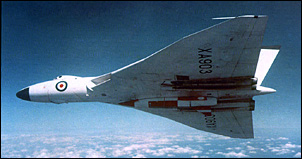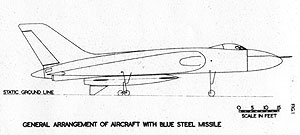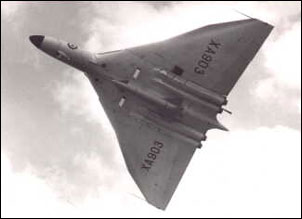Home
Introduction
History
Olympus 593
Tornado RB199

Vulcan B1 XA903 - Blue Steel Trials

![]() XA903 was probably one of the most famous and altered
Vulcans ever built. Used throughout her life solely as a test bed, this
aircraft completed important trials with the Blue Steel missile project,
Concorde engine development and finally with the Tornado engine
development. Here we take a look at its early days, when it was the first
Vulcan to carry Blue Steel, and in fact the only B.Mk1 Vulcan to carry
this missile.
XA903 was probably one of the most famous and altered
Vulcans ever built. Used throughout her life solely as a test bed, this
aircraft completed important trials with the Blue Steel missile project,
Concorde engine development and finally with the Tornado engine
development. Here we take a look at its early days, when it was the first
Vulcan to carry Blue Steel, and in fact the only B.Mk1 Vulcan to carry
this missile.
On the 10th May 1957, a Vulcan B.Mk1 took off from Avros airfield at Woodford. This aircraft had just rolled off the production line and was making its maiden flight. XA903 was the fifteenth production B1 and was destined for a varied and well-documented career. The 10th also saw XA902, the first white production Vulcan, leave Woodford as it was being delivered to RAF Waddington where it joined 230 OCU. This was the last time XA903 would see its sister XA902, even though it too ended its career as an engine test bed developing Conways and the Spey.
With the arrival of XA902, 230 OCU had received its initial quota of aircraft, it had also by this time run its first pilots training course and the graduates had been posted to 83 Squadron. The next delivery was XA904 when it flew to RAF Waddington on the 16th July and became the first Vulcan to be permanently assigned to a squadron.

![]() XA903 had been earmarked as the test aircraft for the Avro
stand off nuclear missile, Blue Steel, making it the first Vulcan to carry
this new and deadly weapon. Plans had been drawn up for the B.Mk1 fleet to
be converted to carry Blue Steel (right) although this was dismissed by
the Ministry. This was probably due to their limited engine power, poorer
electrical systems and the non-cranked front spar making the missile less
recessed into the bomb bay.
XA903 had been earmarked as the test aircraft for the Avro
stand off nuclear missile, Blue Steel, making it the first Vulcan to carry
this new and deadly weapon. Plans had been drawn up for the B.Mk1 fleet to
be converted to carry Blue Steel (right) although this was dismissed by
the Ministry. This was probably due to their limited engine power, poorer
electrical systems and the non-cranked front spar making the missile less
recessed into the bomb bay.
From XA903s inception into the programme it was clear that she would never serve as a standard bomber as many alterations and modifications were carried out which included a B2 nose wheel leg, a complete revamped rear desk and advanced avionics.
XA903 was flown for another three test flights, bringing its flying time up to 5 hours 10 minutes before finally being delivered to Langar by Jimmy Harrison on the 31st May for the new recessed Blue Steel bomb bay doors and other equipment to be fitted. She was not to return to Woodford until the 27th January 1958 when ground tests commenced which included releasing the missile from the aircraft into a large sand box placed a fraction of an inch beneath the missile.
The tests were not fully completed until the 19th April when once again XA903 took to the air. This her seventh flight, was the first for the Weapons Division and had a dummy missile attached. The next flight was on the 9th May with Jimmy Harrison as the first pilot, Jimmy Orrell the co-pilot and Bob Pogson as the AEO.
The first evaluation test flight was on 3rd June 1959 over the Aberporth range. This was to prove the electronics systems and the manoeuvrability of the Vulcan with a fully loaded missile attached, including 2g pull ups and pushovers. On the next day, the first drop of a full sized round took place at 40,000 ft. The pilot was Jimmy Harrison. A.V.Roe Electronics Officer, Brian Prickett, from the Weapons Research Division, was also onboard to oversee the release due to problems that had occurred during earlier trials with the 2/5th scale rounds (launched from Valiant WP204). The missile launched successfully and glided downrange until it was broken up by a ground command, plunging into Cardigan Bay.

![]() Over the next two and a half years XA903 flew a
further 58 times building her flying time up to 102 hours 40 minutes when
she was rewarded with a sunny holiday in Australia, leaving on the 12th
November 1960 and stopping at El Adam, Aden, Gan, Butterworth, Darwin and
finally reaching Edinburgh Field on the 16th. The easiest way to get one
of the missiles out to Australia was for XA903 to carry it, so the
outwards bound journey was with a Blue Steel test round under her bomb
bay.
Over the next two and a half years XA903 flew a
further 58 times building her flying time up to 102 hours 40 minutes when
she was rewarded with a sunny holiday in Australia, leaving on the 12th
November 1960 and stopping at El Adam, Aden, Gan, Butterworth, Darwin and
finally reaching Edinburgh Field on the 16th. The easiest way to get one
of the missiles out to Australia was for XA903 to carry it, so the
outwards bound journey was with a Blue Steel test round under her bomb
bay.
By the 3rd February 1961, after only seven flights lasting a total of 8 hours 25 minutes flying time she departed for her return journey via Darwin, Changi, Gan, Aden, Idris and back to Woodford on the 7th. This was to be her only overseas outing as all other trials with the Blue Steel and later with Bristol Siddeley and Rolls Royce were carried out from UK airfields.
As the later mark Vulcan came off the production line, XH539, a B.Mk2 was earmarked to take over from XA903, leaving her with less and less to do. For large periods of time she was left in open storage, but by December 1963 when her job was finally complete and it was time for her to move on.
At the 25th meeting of the R.D.A.A.P held on the 2nd May 1960, it had been agreed that when either XA899 or XA903 was released from current commitments the first should be allocated to Filton to replace XA894 and on the 19th December 1963 XA903 was officially transferred. With poor old XA894 being no more than a pile of ashes and the Olympus 593 project well under way and with over two and a half years of conversion work ahead the arrival of XA903 was a most welcome sight.